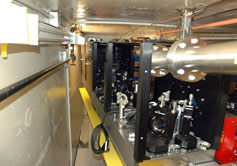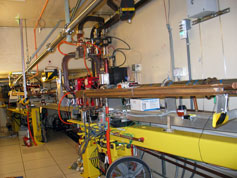
Handy Links
SLAC News Center
SLAC Today
- Subscribe
- Archives: Feb 2006-May 20, 2011
- Archives: May 23, 2011 and later
- Submit Feedback or Story Ideas
- About SLAC Today
SLAC News
Lab News
- Interactions
- Lightsources.org
- ILC NewsLine
- Int'l Science Grid This Week
- Fermilab Today
- Berkeley Lab News
- @brookhaven TODAY
- DOE Pulse
- CERN Courier
- DESY inForm
- US / LHC
SLAC Links
- Emergency
- Safety
- Policy Repository
- Site Entry Form

- Site Maps
- M & O Review
- Computing Status & Calendar
- SLAC Colloquium
- SLACspeak
- SLACspace
- SLAC Logo
- Café Menu
- Flea Market
- Web E-mail
- Marguerite Shuttle
- Discount Commuter Passes
-
Award Reporting Form
- SPIRES
- SciDoc
- Activity Groups
- Library
Stanford
Around the Bay
LCLS Laser Heater Installed
As the leaves change and temperatures drop, it's time to turn the heat on—even for the electron beam at the Linac Coherent Light Source. Thanks to some last-minute hard work, the LCLS laser group installed a laser heater for the stream of electrons that will power the X-ray laser. This device will stabilize the electron beam before it is shot into the linear accelerator.
"It's a big step," said William White, the laser group leader. He describes the entire team's efforts as heroic for getting the project done on time under tight conditions.
The heater, installed at the beginning of the electrons' long journey, will solve the problem of electrons bunching before they are injected into the linac. "We'd always planned on the laser heater, but we've actually seen more evidence during the commissioning that it's even more important," White said.
The LCLS will send tiny, controlled bunches of electrons through the linac to produce super-bright pulses of X-rays. Because of the beam's extreme brightness, the electrons can start to bunch prematurely. The early bunching can disrupt the X-ray laser's ability to produce light.
"This uncontrolled bunching is taking place and it's actually impacting some of the beam diagnostics and making them unusable," said White. "Once we have the laser heater working, these diagnostics will hopefully work again."
To stop the premature bunching, the laser heater doesn't actually heat up the electrons. Instead, it acts like the LCLS laser in reverse. Inside the heater, a pulse of infrared laser light travels with the electron beam racing out from its source. Both light and beam pass through a device called an undulator that wiggles the electrons left and right. The electric field of the laser and this wiggling stabilize the beam and prevent early bunching.
"This is a unique system. A lot of people want to build similar systems, but we'll be the first to try it out," said Paul Emma, the leader of the LCLS accelerator group. "So it's exciting."
Sasha Gilevich, the laser heater project manager, and Alan Miahnahri from the laser group didn't have to go far to find an infrared light source for the heater. The light for the heater is produced by the same laser that generates the electron beam. Mirrors direct the laser light to the undulator through several meters of pipe. In only 10 days, Gilevich's team fit feet of optic tubing and the series of mirrors through a tight space filled with pipes and other equipment. Richard Boyce managed installation of mechanical and vacuum components of the laser heater, as well as magnets that steer the beam into the undulator.
"It's a miracle it all got done," said Gilevich.
The heater's undulator is expected to be in place by the end of December to warm up the beam in January.
—Michael Torrice
SLAC Today, December 2, 20088

